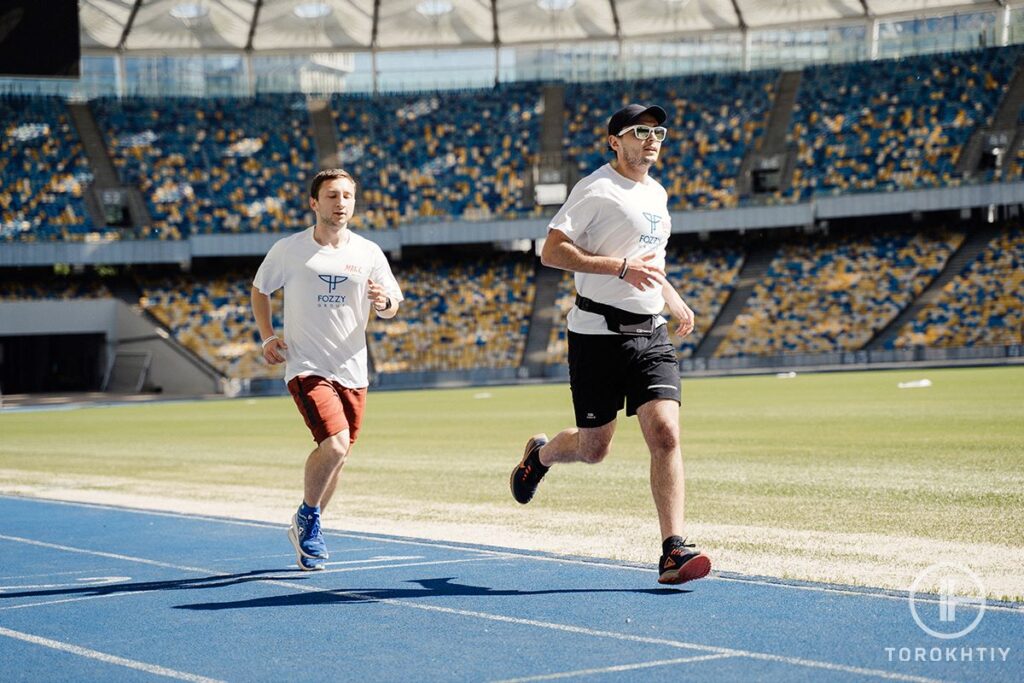How to Reduce Lactic Acid When Running: 3 Tips
Author:
Unlock your full potential by engaging with our experts and community! Have questions about your fitness journey or looking for expert advice on weightlifting techniques? Don’t hesitate — leave a comment below and Ernesto Mendez will provide a personalized answer and insights to help you reach your goals.
Torokhtiy is reader-supported. Some links are affiliate links, and we may earn a commission at no extra cost to you. See our disclosure page for details.
Have you ever experienced the satisfying yet excruciating burn you receive from running? Now and again, you can have a cramp or get tired before you should. It’s a common misconception that runners’ lactic acid is what causes these side effects.
However, the solution is more complex than believing that lactic acid is the only factor. The role of lactic acid buildup from running and how to handle it will be discussed in this article.
What is the role of lactic acid in a runner’s body? – As a runner reaches the anaerobic respiration stage, lactic acid (lactate) builds up in their bodies until the lactate threshold is reached. As a result, lactic acid build up running, causing fatigue and muscular pain.

What is Lactic Acid and the Process of Lactate Production in the Body?
As a runner, you are undoubtedly familiar with the relationship between running and lactic acid, and how it affects your performance. However, broadening your knowledge of what lactic acid is and how it is produced can significantly boost your performance in the long run!
Our bodies generate lactic acid as a byproduct of the production of energy for the body during intense exercise. Normally, our bodies create energy to fuel muscles using oxygen and glucose. However, an alternate process comes into play when exercises restrict oxygen intake, such as high-intensity running.

During glycolysis, the breakdown of carbohydrates produces glucose, creating adenosine triphosphate (ATP), which provides our bodies with energy in exchange for oxygen. This provides our bodies with energy in exchange for oxygen. Lactate created by glycolysis at a cellular level will then transform into ATP to give the body more power.
As you continue running and producing lactic acid, hydrogen ions also increase, causing a reduction in blood pH and creating a more acidic environment within the muscles. However, the body efficiently recycles lactate while clearing hydrogen ions during the running process, leading to a continuous supply of energy.
Now that you know how and why lactic acid develops in runners legs, let’s explore its impacts on runners.
How Lactic Acid Affects Runners?
The lactic acid from running will vary depending on the type of running they do. Whether you’re competing in an ultra-marathon, like the Ultra-Trail du Mont Blanc or the Comrades marathon in South Africa, or if you’re sprinting, your level of lactic acid buildup will be different.
The level of lactic acid buildup differs due to the activation of distinct muscle fibers in each sport. Long-distance runners primarily rely on slow twitch muscle fibers, which take longer to warm up, and experience fatigue later. Look now it makes clear sense.
Short-distance runners or sprinters rely on fast twitch muscle fibers, which warm up fast but fatigue earlier. We will focus on the buildup of lactic acid while running long distances.

Lactic acid is primarily produced in our muscles as we break down glucose for energy. When oxygen levels decrease during intense exercise, a molecular process occurs, leading to the creation of lactate. This lactate is then transformed into adenosine triphosphate (ATP), providing us with a continuous supply of energy.
1. Lactate Threshold
The lactate threshold is an important concept for all runners as it correlates with their VO2 Max, impacting their performance efficiency. When you reach your lactate threshold, your ability to perform efficiently starts to decline. To determine your lactate threshold, a similar test to VO2Max testing is conducted.
During the lactate threshold, you run on a treadmill while blood tests are taken every three minutes. The exercise intensity gradually increases, elevating your heart rate and the amount of energy needed in your muscles. A higher average VO2 max indicates a higher lactate threshold.
This means that runners with better cardiovascular fitness can tolerate higher lactate levels before experiencing a decline in performance.
2. More On Lactate
We have discussed lactate production to a certain degree, but it’s also helpful to note how our bodies create energy through different energy pathways. Aerobic and anaerobic respiration are crucial in supplying power to the body.
At first, many believed aerobic respiration turns glucose into energy when combined with oxygen. Likewise, anaerobic respiration only starts when you reach your specific physical limit or heart rate zone. Anaerobic respiration was also known to convert glucose into energy in the absence of oxygen, resulting in the production of lactic acid as a waste product.
However, advancements in technology and research have revealed that anaerobic respiration is consistently active, transforming glucose into a compound known as pyruvate. Hydrogen ions are released at the same time as the creation of pyruvate.

On the other hand, aerobic respiration filters out and cleans the pyruvate by using oxygen to burn it into water and carbon dioxide to remove it. Lactate is a byproduct of this process.
While you run, your body will produce pyruvate and acid until it is too much for your aerobic respiration to clean out. Then anaerobic will takes over, using a pyruvate molecule and hydrogen ion to create lactate.
Is Lactic Acid Bad for a Runner?
The answer isn’t as simple as yes or no, but lactic acid is not bad for a runner. Lactic acid and running are inherently interconnected; one comes with the effect of the other. Lactic acid provides additional energy as we reach higher-intensity exercises.
However, attributing all muscular pain, cramps, and burning while running solely to lactic acid buildup oversimplifies the complex relationship.
We’ve covered how lactic acid provides bodies with energy and how the production of lactate and hydrogen go hand in hand. The answer to why you feel that invigorating yet debilitating burn when running, and the pain afterward lies somewhere in the middle of these two chemicals.

The initial understanding was that lactic acid was the cause of all muscular pain. However, extensive studies showed that lactate and hydrogen ions have a 1:1 ratio. With equal proportions, that rules out the possibility of discomfort and distress caused by only one chemical.
3 Ways How to Control Lactic Acid During Running
While you cannot completely control the effects of lactic acid during running, several strategies can help optimize your performance and minimize the impact of lactic acid buildup. By incorporating these approaches into your running routine, you can learn how to prevent lactic acid build up while running, thus enhancing your overall running experience.
Remember, as you run, your body will continue circulating the lactate until you reach your threshold. Running at a faster pace increases lactate production, while slowing your pace reduces the demand for excess energy and, subsequently, the amount of lactate produced.
Lactic acid from running often affects runners’ legs. With lactic acid accumulating in feet and in calves, it can easily lead to cramps and muscular pain. Here’s how to reduce lactic acid while running.
1. Focus of Your Aerobic System
As mentioned before, lactate production only starts once your body gets to the point where it needs to switch from aerobic respiration to anaerobic respiration. So, how do you improve your aerobic respiration system?
Doing exercises such as jogging, swimming, and rowing, and increasing your usage of the aerobic system, all require you to change how intensely you do them. The first step is to train at a moderate level during these activities.
Stick to a heart rate zone that is comfortable to maintain but involves an adequate progress overload. Doing so will increase your VO2 max, and improve your aerobic system.
2. Do Threshold Runs
A threshold run is when you do just enough to keep the run challenging but still comfortable. The concept refers to running at a capacity or pace under your threshold to improve it slowly. This is also one way you can reduce lactic acid while running.

3. Stay Fit
Maintaining fitness is crucial for optimizing your body’s ability to process and clear lactate before it accumulates and leads to cramps. Research has shown that athletes training at highly competitive levels have less lactate accumulation in their blood at different testing intervals. Their bodies efficiently remove lactate, contributing to their enhanced performance.
On the contrary, less active individuals may encounter difficulties with lactic acid buildup since their bodies are less proficient at reusing it.
Consequently, lactic acid in the legs running to the feet and back is unable to get to the liver and kidneys where it can be recycled for reuse, resulting in pain or burning specifically in these areas of our bodies.
Is it possible to improve the production and reuse of lactic acid?
Now that we know a little about what lactic does for us, how do we optimize its effects to improve our performance? In order to improve the reuse and production of lactic acid, runners can focus on their Aerobic and Anaerobic respiration. Let’s explain this further:
1. Improvements in Aerobic Respiration
For long-distance runners, understanding this question is vital. If you’re running an endurance race, a few hours long, you will want to run within a heart rate zone that uses your aerobic system efficiently. For many, this is called Zone 2. Zone 2 might vary depending on your VO2 Max.
While running in Zone 2, you might find the run comfortable and relatively easy. This should stimulate your aerobic system’s ability to function optimally to produce energy. The result will be that your body will be able to produce and reuse lactate more because it has the time to do so.
2. Improvements for Anaerobic Respiration
Promoting the creation and reuse of lactic acid by running shorter distances, like 10km faster, is slightly different. To improve the production of lactic acid, you want to optimize the creation of ATP without oxygen. Research has shown that athletes show the most improvement when they exercise within the zone 4 heart rate zone.
Allowing the lactate and hydrogen ions to transfer from your fast-twitch muscle fibers to your slow-twitch threads is also an efficient way to improve your running. Training methods, like Fartlek training, are great as they require you to train above your lactate threshold for a time and then drop below it again.
Hoka Bondi 8
- Material: Breathable and supportive mesh upper
- Sole Material: Full-length EVA midsole for maximum cushioning
- Outsole (tread feature): Durable rubber outsole with a unique lug pattern
- Drop: 4mm
- Season: Suitable for all seasons
- Special Features: Exceptional cushioning and comfort
- Size: Available in various sizes
- Type: Maximum cushioning running shoe
If you want excellent running or walking shoes or just footwear you’ll be comfortable in, you can’t go wrong with the Hoka Bondi 8.
It’s been upgraded and now they have lighter, softer materials and a new extended heel design. The heel design gives a super soft, balanced feeling from th emoment your heel hits the ground to when you push off with your toes.
As far as the weight goes, it’s around 10.80 ounces, and the heel drop is 4 mm. They’re not too heavy and the lower drop is a good balance between cushioning and feeling connected to the ground.

The Bondi 8 is focused on cushioning and keeps things simple. There’s a good amount of support without any extra stuff that you don’t really need and that would only jack up the price. Take the rear crash pad, for example – it makes for a soft, smooth ride, which is perfect if you like to run outdoors.
The upper part is made of engineered mesh, which is breathable and keeps your feet cool and dry. The tongue and collar have memory foam and mold to your foot shape. All of these features make the fit snug but flexible, which is exactly what you would want.
The Bondi 8 is eco-friendly because it uses recyclable materials in parts like the mesh and the sockliner. Plus, the shoes are completely vegan, which (if that’s important to you) is nice!
Frequently Asked Questions About Lactic Acid in Runners
How to Get Rid of Lactic Acid when Running?
Our bodies naturally reduce and remove lactic acid from our systems. To effectively cleanse your lactic acid system, the best solution is to take a break and rest for a while. Allowing your heart rate to decrease during this rest period encourages the filtration of lactic acid from your system.
What are the Three Symptoms of Lactic Acid?
Some early signs that you might have a buildup of lactic acid include exhaustion and fatigue, respiration compensation, muscle cramps, and body aches.
Final Thoughts About Lactic Acid in Runners
In short, there’s a common belief that lactic acid is the culprit behind cramps, muscular pain, and fatigue in runners. However, research has shown that this is not the case. Lactic acid is actually a natural byproduct produced when our bodies create energy without enough oxygen.
The real issue arises when we can’t efficiently recycle and reuse the lactic acid, leading to discomfort. But here’s some good news – you can reduce lactic acid buildup while running by improving your overall fitness.
We’d love to hear from you! Share your experiences with lactic acid in the comment section below and let us know how you manage its effects during your runs.
Also read:
References:
- Physiology, Adenosine Triphosphate // NCBI: https://www.ncbi.nlm.nih.gov/books/NBK553175/
- Anaerobic Threshold: Its Concept and Role in Endurance Sport // PMC: https://www.ncbi.nlm.nih.gov/pmc/articles/PMC3438148/
- Pyruvate // PubChem: https://pubchem.ncbi.nlm.nih.gov/compound/Pyruvate
- Point: Muscle lactate and H+ production do have a 1:1 association in skeletal muscle // American Physiological Society Journal: https://journals.physiology.org/doi/full/10.1152/japplphysiol.01506.2010
- Anaerobic Threshold: Its Concept and Role in Endurance Sport // PMC: https://www.ncbi.nlm.nih.gov/pmc/articles/PMC3438148/
- Photos by Torokhtiy Media Team.
Why Trust Us?
With over 20 years in Olympic weightlifting, strength training, nutrition coaching, and general fitness our team does its best to provide the audience with ultimate support and meet the needs and requirements of advanced athletes and professional lifters, as well as people who strive to open new opportunities and develop their physical capabilities with us.
By trusting the recommendations of our certified experts in coaching, nutrition, and sports training programming, as well as scientific consultants, and physiotherapists, we provide you with thorough, well-considered, and scientifically proven content. All the information given in the articles concerning workout programming, separate exercises, and athletic performance, in general, is based on verified data.
The product testing process is described in more detail here.
Author: Ernesto Mendez
Orthopedic Clinical Specialist
Best Results: Snatch – 208 kg,
C&J – 240 kg
Dr. Ernesto Mendez is a licensed physical therapist, a board Orthopedic Clinical Specialist (OCS) and founder of Movement 4 Wellness Physical Therapy, LLC. He earned his degree from Thomas Jefferson University. He is also an Olympic weightlifting coach (USAW L1) and Functional Fitness Level 1 Trainer. His experience includes the areas of pain management, movement analysis, injury recovery, surgical rehab, corrective exercise, and athletic, military, and occupational performance. Dr Mendez is passionate about Olympic weightlifting and fitness. Ernesto Mendez is responsible for designing multiple training programs, writing blog articles, posting daily weightlifting content, doing live weightlifting and mobility seminars.




Still have questions after reading our article? Unlock your full potential by engaging with our experts and community! Don’t hesitate — leave a comment below and Ernesto Mendez will provide a personalized answer and insights to help you reach your goals.